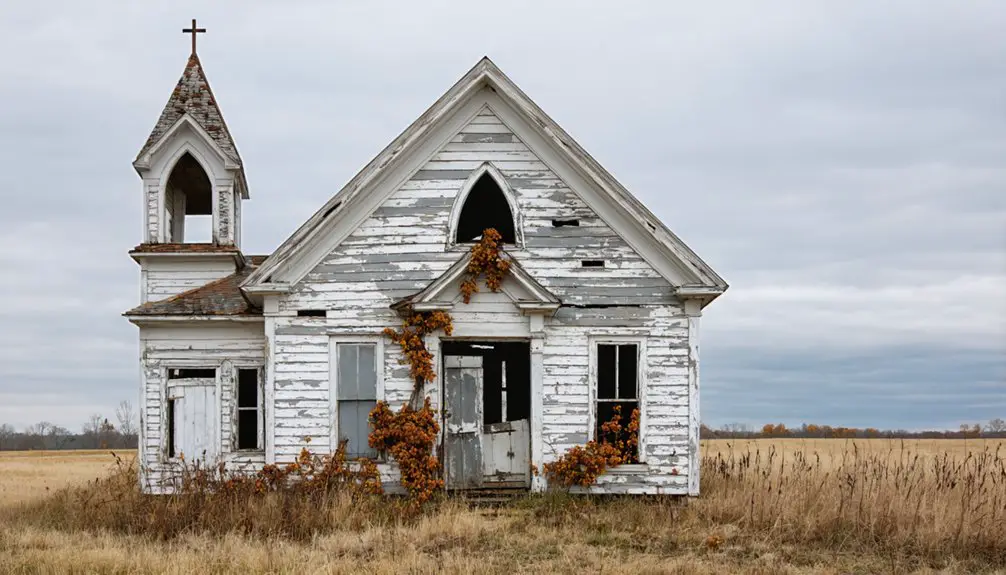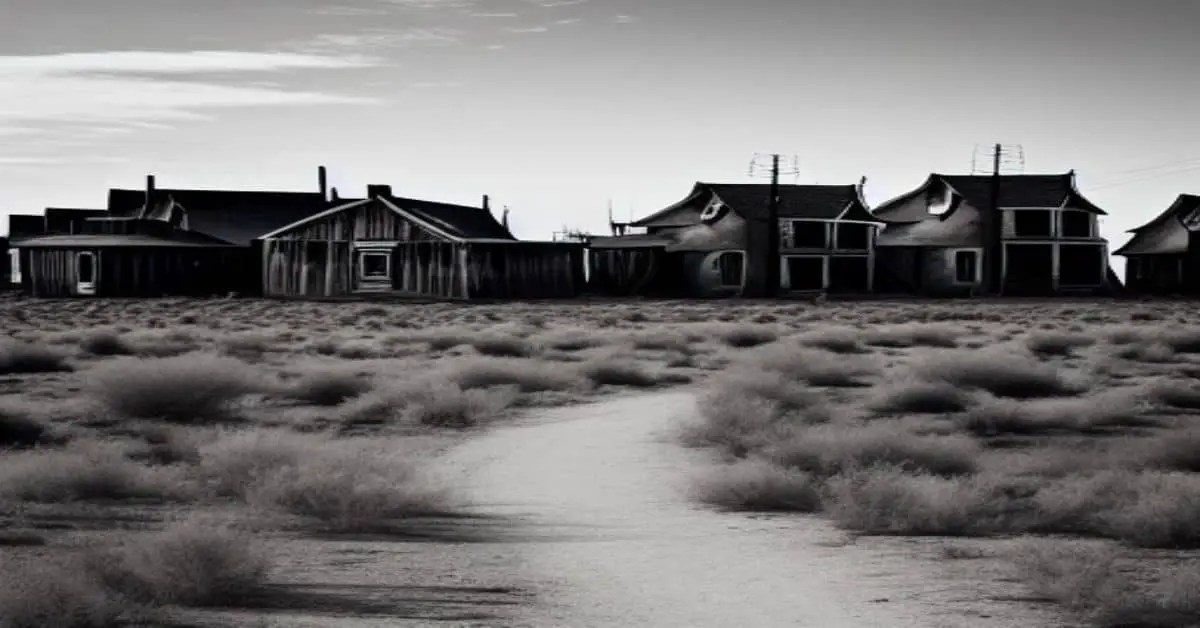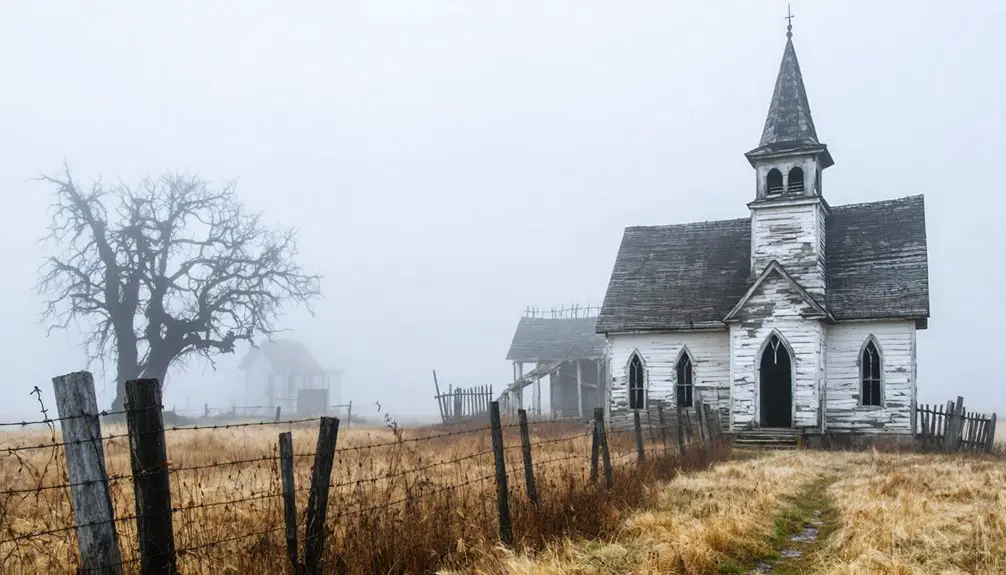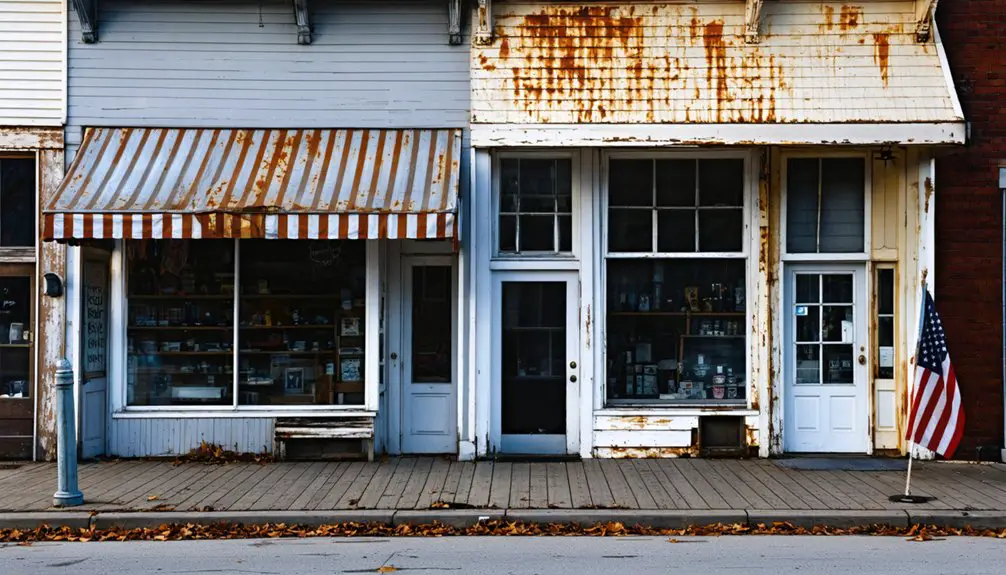You’ll find Arlington, Missouri’s ghost town remnants along a quiet stretch of old Route 66, where this once-bustling railroad town now stands frozen in time. Founded in 1867 as Little Piney, Arlington thrived until Interstate 44’s construction in 1966 sealed its fate. Today, about 20 residents remain among deteriorating structures like John’s Modern Cabins and the Arlington Hotel, while unpaved roads lead to fascinating ruins that tell a deeper story of boom-to-bust Americana.
Key Takeaways
- Arlington transformed from a thriving Route 66 town into a ghost town after Interstate 44 bypassed the community in 1966.
- The town’s decline accelerated after the closure of its post office in 1958 and demolition of the original Route 66 bridge.
- Today, Arlington has only 20 residents, with abandoned structures like John’s Modern Cabins deteriorating along the old roadside.
- Founded in 1867 near Little Piney River, Arlington peaked during the late 19th century as a lumber industry hub.
- Visitors can explore Arlington’s ruins along a three-mile stretch of Arlington Road, accessible from Interstate 44’s Exit #176.
From Little Piney to Arlington: Origins of a Railroad Town
When Thomas Harrison platted the townsite near the Little Piney River‘s mouth in 1867, he laid the foundation for what would become Arlington, Missouri.
Harrison, a Virginian, witnessed rapid town planning efforts that resulted in about 30 buildings either completed or under construction shortly after establishment. You’ll find the town’s original name, Little Piney, changed to Arlington in 1868 with the post office’s establishment – a tribute to Confederate General Robert E. Lee‘s Virginia plantation.
The early settlers relied on navigable streams for transportation and movement of goods and supplies. As railroad expansion reached the eastern bank of the Gasconade River, Arlington’s strategic position as a railway station fueled its early growth. The town became an important lumber shipping point for the surrounding region.
Transportation Routes Shape a Community
Throughout Arlington’s history, transportation infrastructure played a pivotal role in both the town’s rise and eventual decline. You’ll see this transportation evolution reflected in the St. Louis-San Francisco Railway‘s early influence, bringing urban visitors to Arlington’s outdoor attractions in the 1890s.
The town’s community identity flourished as steel bridges and improved highways replaced dirt roads, with Highway 14 connecting St. Louis to Springfield. The legacy of this road network would later become part of the historic Mother Road that stretched from Chicago to California. Like Charlotte’s mixed-use development approach, Arlington adapted to changing transportation needs by combining residential and commercial spaces along major routes.
Steel bridges and paved highways ushered in Arlington’s golden age, connecting small-town life to the promise of metropolitan progress.
Route 66’s expansion in 1957 marked a significant shift, forcing local businesses to relocate or demolish.
When Interstate 44 bypassed Arlington in 1966, you’d witness the town’s dramatic transformation. The new highway diverted traffic, closed the post office, and pushed businesses like the Gassers to relocate to Rolla.
This modernization ultimately transformed Arlington from a vibrant transit hub into a ghost town.
The Golden Age of Arlington’s Commerce
During its economic peak in the late 19th century, Arlington flourished as a bustling commercial hub centered on its thriving lumber industry.
You’d find crucial commercial establishments strategically positioned throughout the town, including a general store, drug store, hotel, and sawmill that served both locals and visitors by 1874.
The town’s status as a railroad terminus amplified its importance in lumber shipping, creating opportunities for logistics and mercantile services. The establishment of the railroad line enabled lumber companies to expand rapidly, with the number of timber operations growing from 319 to 1,199 between 1879 and 1889.
Many local businesses resembled the mom-and-pop establishments that would later characterize Route 66’s heyday through Missouri.
You could witness a diverse mix of businesses, from restaurants and barbers to wholesale merchandising operations, all supporting the growing population and steady stream of travelers.
Local manufacturing focused on wood products, while the general store acted as a crucial community center where you’d discover daily necessities alongside manufactured goods brought in by rail.
Life Along Historic Route 66
During Route 66’s heyday through Arlington, you’d find thriving establishments like Gasser’s Tourist Court and the popular Stony Dell Resort offering weary travelers a perfect respite along America’s Mother Road.
You could spot unique attractions like Vernell’s Motel with its distinctive petting zoo and restaurant serving up hearty comfort foods that drew motorists from miles around.
The town began its journey as Little Piney before taking on its current name in 1867. Your journey through Arlington changed dramatically after the 1950s when the four-lane bypass and later Interstate 44 redirected traffic away from these once-bustling businesses, leaving them to fade into history. The area’s humid subtropical climate made it an appealing stop for travelers seeking shelter from both summer heat and winter storms.
Route 66 Glory Days
When Route 66 reached its zenith in the mid-20th century, this iconic highway offered travelers a vibrant tapestry of roadside culture that defined American mobility.
You’d find welcoming motor courts, bustling roadside diners, and friendly service stations dotting the 2,448-mile stretch from Chicago to Los Angeles. This Route 66 nostalgia emerged from a genuine culture of hospitality, where local businesses thrived on passing travelers and trucking traffic. After World War II, the highway became a vital artery that supported economic growth during challenging times. The post-1945 era saw a remarkable surge in leisure travel as Americans embraced the freedom of the open road.
The road’s transformation from its humble 1926 beginnings was remarkable.
What started as mostly unpaved, hazardous dirt roads evolved into a crucial corridor connecting eight states. You could experience the freedom of the open road while relying on a network of repair shops, fuel stops, and restaurants that turned highway travel from an intimidating challenge into an achievable adventure.
Roadside Tourist Attractions
From quirky roadside oddities to historic motor courts, Missouri’s stretch of Route 66 boasts an impressive collection of tourist attractions that capture the highway’s golden era.
You’ll discover the massive Route 66 Rocker in Fanning, where you can snap photos of the 12-meter-tall rocking chair, or explore the mysterious Meramec Caverns, supposedly Jesse James’ hideout.
For authentic roadside diners and treats, don’t miss Ted Drewes Frozen Custard in St. Louis or Missouri Hick Bar-B-Que in Cuba.
The quirky attractions continue at the Uranus Fudge Factory, while vintage accommodations like the historic Wagon Wheel Motel and Best Western Route 66 Rail Haven let you experience the authentic motor court lifestyle.
The Old Chain of Rocks Bridge offers a unique pedestrian experience with its distinctive 22-degree bend over the Mississippi.
Decline After Interstate Bypass
The construction of Interstate 44 in the 1950s dealt Arlington a devastating blow, severing its lifeline to the steady stream of Route 66 travelers.
The 1966 demolition of the original Route 66 bridge near town completed Arlington’s community isolation, leaving it stranded at the end of a dead-end road.
You’ll find evidence of the tourism decline in the ruins of once-thriving businesses like Vernell’s Motel and John’s Modern Cabins, which couldn’t survive after the bypass redirected traffic away from town.
The post office’s closure in 1958 further signaled Arlington’s downturn.
Even ambitious plans for a resort development failed to materialize, and by the mid-20th century, Arlington had fully transformed into a ghost town.
The RV park that operated until 2008 served as the last remnant of the town’s tourist economy.
Architectural Heritage and Notable Structures
As Arlington flourished alongside the Pacific Railroad in the late 1800s, its architectural landscape emerged through a mix of commercial, residential, and transportation-related structures.
You’ll find remnants of this heritage in the town’s surviving buildings, including the historic sites near Route 66’s dead end. The architectural styles ranged from utilitarian railroad structures to tourist accommodations like John’s Modern Cabins and the Totem Pole Tourist Camp, both established in 1933.
Notable transportation infrastructure included two 1923 steel bridges and a significant 1932 bridge, reflecting early 20th-century engineering. While many structures haven’t survived, historic preservation efforts have maintained some buildings, though they’re largely in ruins.
You can still spot converted residences, deteriorating outhouses, and the skeletal remains of tourist cabins that once served travelers.
Economic Forces Behind Arlington’s Decline
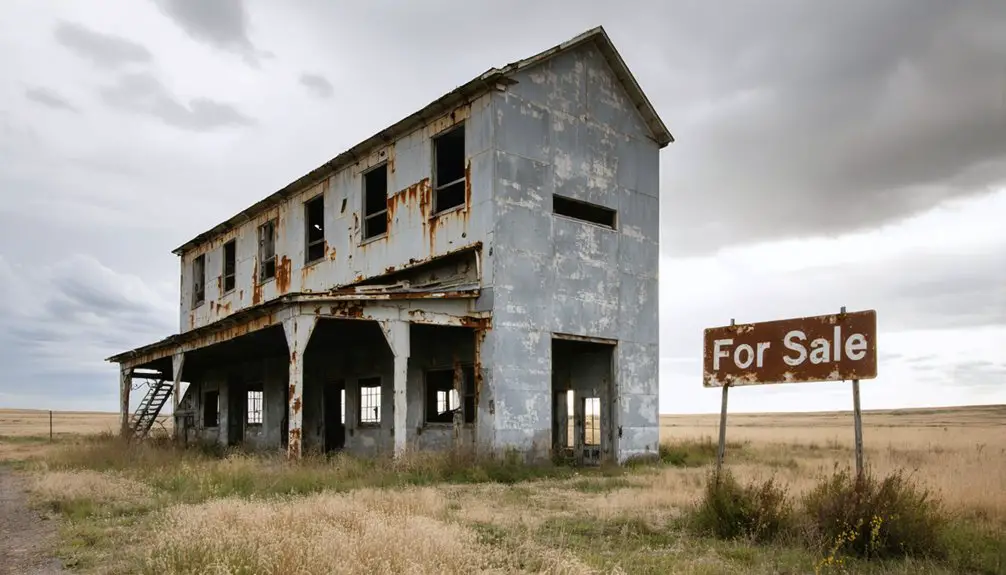
While Arlington once thrived as a bustling transportation hub along Route 66, several interconnected economic forces triggered its eventual downfall.
You’ll find that transportation changes dealt the heaviest blow, starting with Route 66’s re-routing in the mid-1940s and culminating with Interstate 44’s construction in 1966, which completely bypassed the town. These shifts devastated local businesses that relied on through traffic.
The town’s economic decline accelerated as river commerce dwindled and once-popular attractions like Stony Dell Resort shuttered their doors.
As river trade faded and beloved destinations closed down, Arlington’s spiral into economic hardship gained momentum.
You can trace Arlington’s transformation into a ghost town through the systematic closure of its core businesses, including the Arlington Hotel and river resorts.
Present-Day Remnants and Ghost Town Status
Today, Arlington’s ghost town remnants are evidenced by its handful of deteriorating structures and sparse population of roughly 20 residents.
You’ll find the old Arlington Hotel still standing alongside several private homes, while John’s Modern Cabins slowly crumble near the roadside.
The modern isolation is stark – I-44’s construction sealed the town’s fate by bypassing it entirely in 1966, removing the essential Route 66 connection that once brought visitors to this thriving community.
What remains is difficult to access, tucked away on a dead-end road that’s far from the interstate’s busy lanes.
While some historical markers and vintage signage survive, most structures lack modern amenities.
The former RV park’s 2008 closure marked the end of commercial activity, leaving Arlington frozen in time.
Maneuvering through Arlington’s historic sites requires careful planning and preparation due to the town’s remote location and deteriorating infrastructure.
You’ll find the historic navigation begins at Exit #176 off Interstate 44, followed by a westward journey on Arlington Outer Road to the old Route 66 pavement.
As you explore the three-mile stretch along Arlington Road, you’ll encounter ruins like Vernell’s Motel and John’s Modern Cabins.
Be aware that many roads are unpaved, and warning signs mark hazardous areas.
For site preservation purposes, respect private property boundaries and avoid trespassing.
Since there aren’t many informational markers, you’ll need to rely on GPS coordinates, vintage maps, and online resources to identify specific locations.
Look for utility poles and old brick structures as visual reference points during your exploration.
Legacy of a Lost Missouri Town
Emerging from humble beginnings as “Little Piney” in the late 18th century, Arlington’s legacy represents a quintessential story of America’s transportation-driven boom and bust cycles.
You’ll find traces of community resilience in its evolution from a coal-mining settlement to a thriving Route 66 destination, where the Arlington Hotel once welcomed weary travelers and Fort Leonard Wood personnel.
Today, Arlington evokes cultural nostalgia for a bygone era when railroad whistles and highway traffic defined small-town prosperity.
While Interstate 44’s construction sealed its fate, Arlington’s story mirrors countless American communities that rose and fell with changing transportation patterns.
The town’s remaining structures stand as silent witnesses to an era when local businesses, tourist cabins, and social spaces created a vibrant community along America’s historic highways.
Frequently Asked Questions
Are There Any Surviving Descendants of Arlington’s Original Founding Families?
You’ll need to consult historical records and genealogical databases to verify family lineage, as there’s no conclusive documentation of surviving descendants, though some residents may have ancestral connections.
What Natural Disasters or Significant Weather Events Impacted Arlington’s History?
You’ll find major flooding impacted local bridges and businesses, while seasonal storms battered tourist cabins along the Little Piney River. Though no direct tornado strikes occurred, regional severe weather threatened transportation routes.
Did Any Famous People Ever Stay at the Arlington Hotel?
You’ll find the Arlington Hotel’s famous guests included presidents like FDR and Truman, gangster Al Capone who rented the entire fourth floor, and celebrities like Babe Ruth and Tony Bennett throughout its history.
Were There Any Schools or Churches Established in Arlington?
Despite a peak population of 1,200 in the 1890s, you won’t find records of any established schools or churches. The town’s focus on railroad and tourism overshadowed development of permanent community institutions.
What Native American Tribes Originally Inhabited the Arlington Area?
You’ll find that the Osage tribe dominated this region’s tribal history, with significant cultural significance. Other tribes like the Missouri (Oneota), Delaware, and Shawnee also called these lands home.
References
- https://101theeagle.com/what-used-to-be-little-piney-on-route-66-now-missouri-ghost-town/
- https://www.frrandp.com/2020/09/the-ghost-town-of-arlington-missouri.html
- https://www.theroute-66.com/arlington.html
- https://www.legendsofamerica.com/arlington-road-missouri/
- https://ominous.app/browse/site/18503
- https://sgcld.thelibrary.org/lochist/history/paspres/ch7.html
- https://www.oldstagecoachstop.org/webgeezer/Gazette05/tiehacking.pdf
- https://www.nps.gov/orgs/1453/upload/Special-Resource-Study-Route-66-Illinois-Missouri-Kansas-Oklahoma-Texas-New-Mexico-Arizona-and-California_12_9_24.pdf
- https://shsmo.org/route66
- https://en.wikipedia.org/wiki/Arlington
